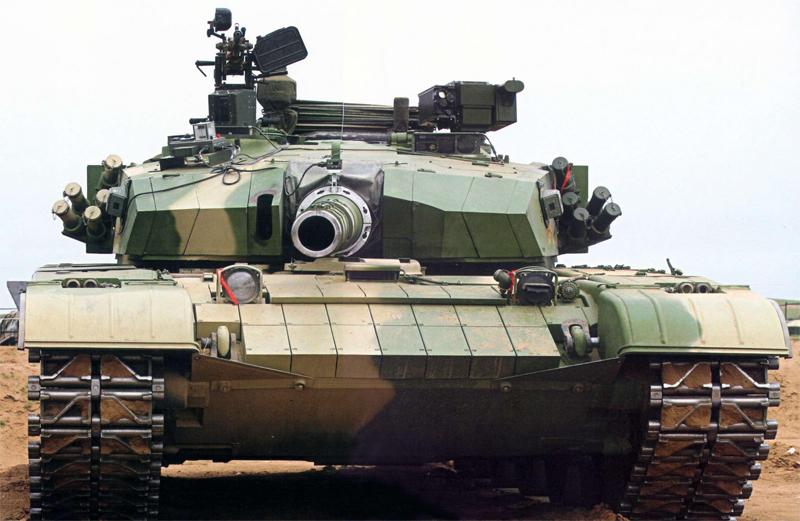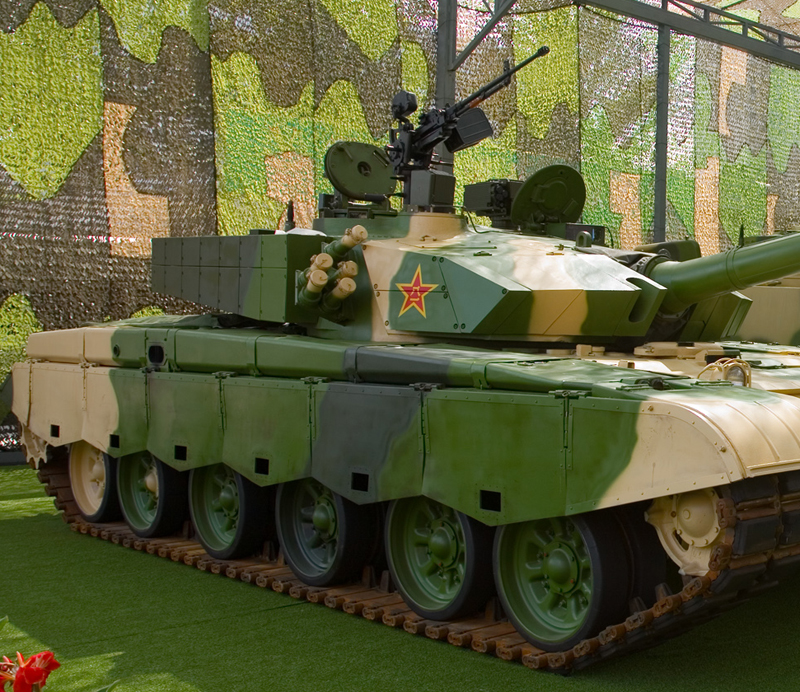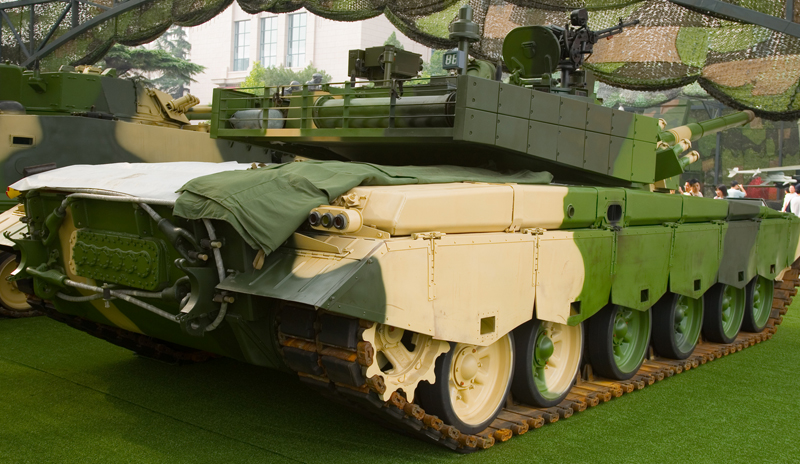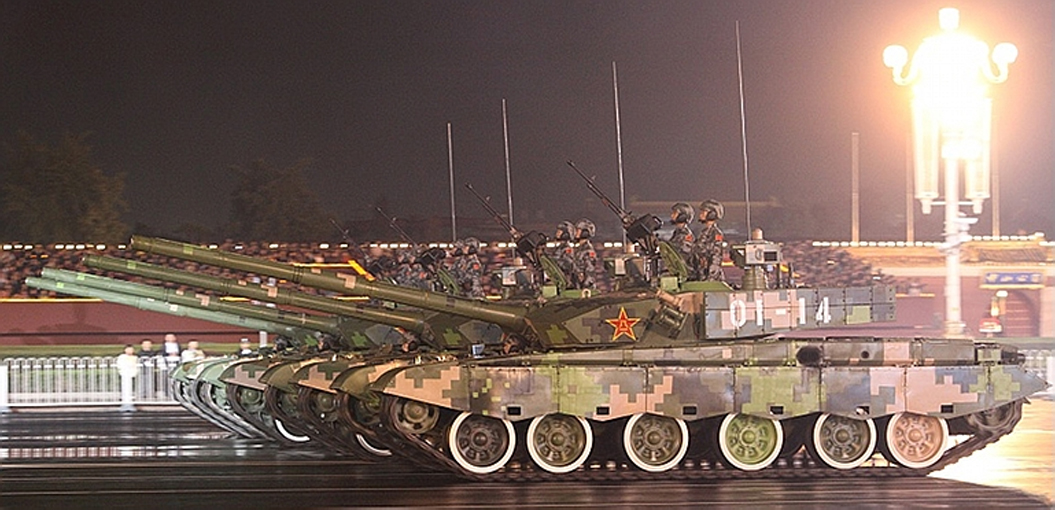The Chinese main battle tanks lineage.
The Chinese tank development can be traced back to the fifties, well before the relationships with USSR were seriously damaged, and the former "great brother" became a potential threat. China PLA was first equipped massively with the most current soviet models, Type 58, which was a Chinese derivative of the famous T-34/85. Later came the first Chinese design, the Type 59, a basic copy of the T-54.Next came the Type 62. During the Sino-Soviet conflict of 1969, one T-62 was captured and served as a base for a complete overhaul of the Type 59 which became the Type 69 (once again, resembling closely to the T-62).
Both improved Type 59 and Type 69 MBTs were still in service during the eighties, after perhaps 15 000 of them has been built. Largely upgraded with western technologies, the Type 69 became the first generation MBT, Type 79. Then came the second generation Type 85 from North Industries Group Corporation, Type 88
Chinese MBTs of the 3rd generation
After years of improvements, the next second generation Chinese MBT was produced by North Industries Group Corporation (Norinco). The Type 90 was a domestic design, withe some Russian influence and Western technologies like a British diesel and French suspension system. For its attractive cost, like former generations of Chinese MBTs, the Type 90 was built under several variants for export. It became the Pakistani main battle tank, under the denomination ofAl Khalid. In 1997, the next second generation came as the Type 96, an improved Type 90 with experimental features tested on the Type 85-III. It was mass-produced, integrated a domestic reliable 1500 hp diesel and modular ERA composite armor.
The third generation MBT can be traced back as 1981. The definitive design was approved in 1986, and a T80 inspired tank with a western style welded turret and better armor system was studied. The Type 98 came at the end of a long process, as in 1999, first displayed on the national day PLA parade in Beijing. The Type 98 was produced in small numbers and thoroughly upgraded, until being superseded by the Type 99...

Design
The Type 99 was largely based on the Type 98, third generation MBT. Development of this model started in 2001, partly based on the Type 98 G. The main striking difference is the new improved turret, with front deflectors and a new composite ERA armor (which details are, of course, classified), as a new diesel water-cooled engine, capable of 65 km/h cross country and 0-32 kp/h in 12 sec. No doubt it eclipsed the Type 98 and 96...The driver sits in the center front of the hull with a left-side opening hatch. It has a single main episcope forward, integrating night vision (infrared). The layout is generally the same as the Type 98, itself a lenghtened chassis compared to the Type 96, a Chinese interpetation of the T-72. They shared a lot of common design traits. See the Type 96 for more. The biggest change is a longer chassis to commodate a very powerul western-style diesel/multifuel engine and transmission. The turret is an evolution of the Type 96, but with an autoloader. The commander and gunner are seated side by side when buttoned up abaft the main gun, commander to the left with full peripheric cupola, search and gunnery sights, and gunner on the right side. Both has single piece hatches opening to the rear.
Passive Protection range
The tank had the same welded turret as the Type 98, itself derived from the Type 96, however inside its angular design, spaced modular armor integrates composite panels probably improved compared to previous tanks. The applique armor also comprised track skirts agains ATGMs. The ERA (Composite, reactive armour) blocks are well visible on the nose and turret, and were improved on the Type 99A (see below). Armour figures are ellusive, estimated by NATO experts and based on a tank commander interview, is equivalent to more than 1000mm (3.3 feet) of rolled homogeneous armor (RHA), but the range and type of ammunition corresponding to these figures are unknown. The storage baskets on the turret sides at the rear could be used as buffer spaces also protected by ERA.Another part of the passive protection is of course the NBC (nuclear-biological-chemical) protection system with sealing and overpressure, with probably chemical contamination sensors as well. There is also a spall liner inside, and automatic detectors/fire extinguishers both in the fighting and engine compartments with outlets also in the transmission and ammo storage aft. On this chapter, the use of an autoloader enables a clear rear bustle housing extra main ammunition with blow-out panels in case of a cookoff, protecting the crew. The sides are protected by 8 easy to install and replace rubber panels to defeat ATGMs, whereas the upper part of the hull, where the walkway is located, is topped and protected by a continuous block of side armour, with various composite fillings, secured by six metal straps. Both front lights and rear lights are protected by light framing.
Active Protection range
The tank feature as a 3rd generation, a generous array of active protection system: Chief of which is a laser-based self defense weapon (LSDW) system. There is also a laser warning receiver system (detecting enemy targeting devices) with probable automatic activation of various countermeasures, like an illuminator and at shorter ranges, no less than twelve 81-mm smoke grenade launchers, plus the additional smoke screen inherited from Soviet practices, the fuel injection system onto the engine's exhaust system.The JD-3 (ZM87) active laser self-defense weapon is a 360° system located behind the tank commander hatch. It was tested on a Type 98 prototype and improved over the years. After receiving enemy laser illumination, it alerts the crew, while simultaneously activates a low-intensity laser to search and locate the source. Once located, the beam is intensified to blind the enemy gunner and if possible damage the optic sensors, with high-power. Its range of application makes it efficient against ground vehicles at 4000 m+ range as well as low-flying helicopters also having these systems; Its high energy means it can not only disrupt guidance signal but damaging the gunner's eyesight permanently.
The JD-3 also integrated a jammer, interfering with SACLOS-guided ATGMs such as NATO's MILAN with a range initially of 3,000 metres (9,800 ft) on the Type 99 and gradually improved. The system also can be used as laser transmitter, for line-of-sight (LOS) communication and IFF.
Powerplant & Mobility
The centerpiece of the new tank is its western state of the art powerplant courtesy of KMDB. It is a turbocharged 1,500 hp diesel derived from the German MB871ka501. Named HP150 it has a power-to-weight ratio of c27.78 hp/ton and manual transmission 6+2 (later upgraded) for top road/off-road speeds of 80 km/h and 60 km/h over 500 km of cruising range. Like previous models, the Type 99 could be equipped with a snorkel kit for deep fording enabling a depth of 4.5 meters. The vehicle could cross without preparation up to 1.20m of water, up to the level of the exhaust however.The suspensions system and drivetrain is also essentially brand new, albeit still very close to the Type 98 MBT. There is a range of doubled cast roadsheels bolted to the axle frame, with the same exact management. The Type 98/99 are very peculiar as their main six roadwheels are placed unheavenly along the chassis. There are two close ones front and rear with torsion bars and additional shock absorbers, and two "supporting" center roadwheels under the turret, far apart.
The Type 99A instead has all its roadwheels close together. The double roadwheels are of a Chinese type inspired by the T-72 and created for the Type 96, not derived from those, smaller, on the Type 80/88. They are eight spokes types and ruberrized, rolling on single pint double bracket track links, which are padded to lower vibrations. This ensemble procures a far smoothier drive compared to the 1st and 2nd gen Type 59/69/79. There are also four return rollers (outwards two recessed) to support the weight of the tracks, front idlers and rear drive sprockets.
Armament
Like theT-80 tanks the Type 99 is fitted with an autoloader with carousel for its 120 mm main gun, and some features from the German Leopard II were adopted.
Main Gun: ZPT98
The 1985 designed ZPT98 (derived from Russian 2A46) is a 50 caliber smoothbore gun inspired by the Rheinmetall equivalent iused on the Leopard 2A6. It is fitted with a carousel-style auto-loader (derived from the T-72 MZ autoloader), capable of a 8 rounds per minute, firing rate in automatic mode, down to 2 rpm in manual backup. The gun is provided with a thermal sleeve and fume extractor. It is also capable of firing the AT-11 laser-guided anti-tank missile (ATGM) or depleted uranium rounds (DU).There is a 2-plane stabilization system and it can be fired under either computerized or manual control. The caliber means it could be fed with any Chinese, Russian, and ex-Warsaw Pact ammunition, which stockpiles are still massive, as made for the T-72, T-80, T64 and T-90 and Chinese MBTs from the Type 90 onwards.
There are 42 rounds in reserve between the turret bustle and the floor, plus 22 inside the carousel. This comprises a range of armor-piercing fin stabilized discarding sabot (APFSDS), HEAT, and HE-FRAG projectiles, plus training and special rounds.
The Chinese tandem shaped charged GP125 ATGMs are compared to the Russian 9M119 "Invar" with a range of 5,000m (5,460 yards). Traditional ammunitions have a useful range of 3,000m as estimated. The 9M119 ATGMs were made under license.
The DTW-125 Type II APFSDS has been estimated by NATO as capable of defeating equivalent of 700 mm (27 in) RHA (rolled homogeneous armor) at 1000 meters (1093 yds), 600 mm (23 in) at 2000 meters (2,127 yards).
The HEAT ammunition is estimated to penetrate 500 mm (19.7 in) of RHA. Useful range is 5000 meters (5,470 yds) in daylight, 4000 by night.
There is also an unspecified APFSDS-T provided for the Type 99 said capable of penetrating 960 mm (37.8 in) of RHA at 1000 meters and 800 mm (31.5 in) at 2000.
Secondary: QJC-88 + coax.

Secondary armament is a mix of the "usual suspects", a QJC-88 12.7 mm (0.5 inches) heavy machine gun mounted over the commander's cupola for AA or ground defence. It shpuld be noted that it's not a RWS (Remote) system, exposing the commander to be shot at, especialy in an urban environment. It elevates of -4 to 75 degrees, and the rotating cupola and solenoid firing, special cradle ensures a theoretical 360° traverse. The QJC-88 or W85 fires the Soviet-designed 12.7×108mm round. It is capable of 550-600 rounds/minutes at a muzzle velocity of 850 m/s (2,788 ft/s), and uses good old Iron sights. Useful range is c2000m. Same extact system as on the Type 98, 96 and Type 15 as other PLA vehicles.
There is also the usual coaxial Norinco's 7.62 mm MG Type 86 (and evolution of the Type 80 from 1983), based on the Soviet PKM. It fires at 700–800 round/min and 840 m/s (2,776 ft/s) over 1,640 yd (1,500 m with sight adjustments) and could be outfitted with Optical/Night vision scope. It is activated by the gunner using his own IR sight.
Fire Control

Apart the laser warning receiver/emitter/dazzler, there is a laser rangefinder mounted over the gun mantlet, a wind sensor at its tip, and extra sensors on the turret's mast. All this data is fed to a ballistic computer, and the gun is aimed through automatic dual axis stabilization. The commander's own display repeats the gunner's thermal sight image and controls including the main Thermal Imaging System (TIS) whic procures generous x11.4 and x5 view magnification. In addition hs has access to the fully computerized on-board data processing system in order to replace the driver in emergency for aiming and firing, including the loading system and he has his own independent thermal sight with auto-tracking targeting capabilities.
This procures the Type 99 full hunter-killer capabilities. The ISFCS-212 fire control system combines an infrared/all weather automatic target tracker enabling the vehicle to fire on the move thanks to full stabilization of both the gun and gunner thermal sight on same data, advanced ballistic computer and laser range finder. The gunner's own sight means a target acquisition range up to 5,000 meters, whereas his own thermal sight has a magnifucation range of 5x and 11.4x. Sensor data displayed from the computer is wide in range, increasing battlefield awareness.
The ST-16 millimeter wave radar suite is used for target identification (IFF) but also acquisition and tracking of the target using the onboard active laser defense system, a function degraded in mediocre weather condition. The radar system is more reliable in this regard. The displays integrates full digital map interface with the BeiDou global positioning system for navigation, as well as other equipments such as a UHF/VHF radio, as well as an encrypted laser communication system using the same main laser system, inertial navigation system, C4ISR battle management system connected to data-link for better coordination with aviation and infantry at platoon level.
Variants confusion
Back in 2011 there was allegedly as main variants the "Type 99 KM" started in 2010 as a "major upgrade for all Type 99s". (see below) The Type 99 G was introduced in 2007 or 2008, equipped with a new observation and active protection system (APS) with independent commander thermal imaging viewer (see also below). The Type 99A is an upgraded version of the Type 99G, but few details are known. Now this had been written down back in 2011. OSINT progressed in between so we can tell there are only two types for fure: The base ZTZ 99 ("type" is now deprecated), and the ZTZ 99A, a completely new animal, albeit sharing many parts.The Type 99A has a newly design turret roof, which is currently lower. ERA panels are extended around the turret, and hull sides. Other upgrades are mostly computer systems changes. The Type 99A2 was on trials as of 2010. It included many changes of the turret design, gun aiming device, electronics components, armour, suspension, and even the diesel engine leading to the second denomination ZTZ-99 A2. Next production version in under way at Norinco. Total combined deliveries of the Type 99 were 250 units as for march 2012, now we know it circa 600 by 2021. They were forming the spearhead of the PLA armored divisions but were gradually replaced by c600 Type 99A.
Type 99KM (2000)
Another foggy MBT "variant" with emerged in the 2000s, it was cited from Chinese reports (no longer accessible) as shown in a pakistani forum (see in the sources), the Type 99KM was some sort of "supertank", 75 tons, samed modular active protection system with a production order of 200, improved JD-4 type active laser defense system, 2100 hp engine, 80 kph and a ... 155 mm new main gun claimed to be "ten years ahead of the west". In fact the KM was also was cited in the original wikipedia article back in 2010 but no longer. Porpotor.com stated on an undated post probably old, that it was "for mountain warfare and has been adapted for use in high-altitude environments". This is the description of the Type 15, which indeed looked like a "compact Type 99" and uses many if the same technologies.Long story short, the denomination is currently deprecated and unsubstantiated. It does not belong to a recoignised type in the Chinese inventory but rather another named badly translated or just setup to confuse Western intel at the time, for the Type 99A.
Type 99G (2000)
Type 99G, is sometimes referred as Type 99A, Type 99A1 and Type 99A2. The description of its improvements, fire control, targeting and countermeasures systems, autonomous commander thermal imaging viewer, raised and more compact engine compartment are all checking the boxes for the Type 99A and its other denominations used in the West or in China. Long story short it's an old western denomination back in 2000 for the Type 99A in development. However the most interesting is that by 2021 the Chinese Army was claiming operating alongside total of 600 ZTZ 99A alongside with 600 older Type 99s, making for this total of 1200 reported here. In another source, the Type 99G was an export version. However official names for these supposed degraded MBTs for export are "VT-". The "G" stands traditionally for improvement.Type 99A (2003)
General Design
The Type 99A has the driver's hatch repositioned in the center left of the hull and with two main periscopes, with the forward one capable of infrared vision. The hull glacis still features the same right main regulation roadlight and a right side military grade blackout/light visibility light. The rest is about the same, although the hull is revised and more compact. There is no longer gaps in the roadwheel axles. It shares also the same base turret. Only details of the sensors and protection differs.Mobility
The Type 99A shares essentially the same drivetrain as the Type 99, but shortened and more compact, same engine, but an improved CH1000 hydraulic-mechanical semi-automatic transmission, with six forward gears, two reverse. The driver controls by a new steering wheel/yoke, thus a stick-shift transmission, both manual or automatic. There are also gas and brake pedals inspred by standard automobiles, enabling a quicker training of recruits.Protection
The 99A may mount 3rd generation (Relikt-type) ERA proof against tandem-charge warheads. The active protection system is also upgraded, which combined with passive armour up to equivalent 1000mm of rolled homogeneous armor (RHA), according to an interview with the tank's commander. The Type 99A also has a smaller, more compact LSDW (laser-based self defense weapon). It was improved also to 4,000 metres (13,000 ft) in range but the remainder worked as the Type 99's system. Photo: The Type 99A naked.Armament & Fire Control
Same main gun, same ammunition, but a an improved variant of DTW-125 APFSDS (Type IIa) which has a lengthened dart penetrator 720 mm (28 in) long plus denser structure. The Type III (not yet official) has even greater performances. The Type 99A MBT also features an improved fire control system, 3rd generation thermal imaging sight, but also a many fold more powerful ballistic computer, better weather measurement mast, for improved accuracy in mediocre weather conditions. The commander now is given a new independent panoramic sight capable of 360° with laser range-finding function. Both sights are fully stabilized; The new fire control computer is able from the data provided to measure, identify and do the aiming corrections with the muzzle reference system (MRS) and position sensitive detector (PSD) on the move and in real time for greater hit probability.Public Reveal
The ZTZ-99A tank was first publicly dispplayed in the military parade at the Tian'anmen Square in Beijing on September 3, 2015. However it was already seen at "Peace Mission 2014" multilateral military exercise organized by the the Shanghai Cooperation Organization (SCO). The turret top notably reveived a new-type compound armor and the laser dazzler system was said improved. It is slightly taller but 30cm shorter and still a 0.45m ground clearance, and showed superior mobility and agility over the ZTZ-99. This is now the new production standard, but numbers are difficult to come by. Estmated ranged from 500 to 900, the difference being T-99 and T-99KMs. The status of the ZTZ-99A1 is unsure (see below).ZTZ 99A1/A2 (2011)
There is much debate about the reality of the ZTZ-99A1/A2 compared to the ZTZ-99A. Indeed the tank has different designations in China versus outside of China. New designations, now adopted by the west, swapped the old “Type” for “ZTZ” and the Type 99A2 is the denomination given in China versus ZTZ 99A in the West. So can we deduce its just a rebranded 99A ?. Wikipedia, which is to be taken with a bucket of salt states the "A1" is given a new type of ERA installed on the glacis turret front and turret sides, tested by 2011. But the source is deprecated. It was christopher Foss Jane's 2011-2012 armour and artillery catalogue.Note: This is an update of the 2011 article
Links/src on the Type 99
The ZTZ99A, A1, A2 on armyrecognition.com.ZTZ-99A2 on tanknutdave
Type 99 on militarytoday.com
pdf.defence.pk: ZTZ 99KM
The WZ 123, armyrecognition.com
The Type 99 MBT on wikipedia...
A video about the Type 99 on You Tube.
Chinese T-99 (ZTZ-99) MBT specs. | |
| Dimensions : | 11 (with gun) 7,8 x 3,4 x 2,2 m hull () |
| Total weight, battle ready : | 54-58 Tons. |
| Crew: | 3: Commander, Gunner, Driver |
| Propulsion : | Norinco diesel liquid-cooled 1500 bhp, 2100 bhp (KM) |
| Top speed | 80 km/h (50mph) |
| Range/consumption | 600 km -4200 liters |
| Suspension | Torsion bar |
| Armament | 125 mm SB, 7,62 mm Mg coaxial, AA Type 85 12,7mm Mg. |
| Armour : | Classified. ERA, composite |
| Ammunition used | Antipersonal, armour-piercing, HEAT, SABOT, HE Frag. |
| Total production | Current - 814 as of mid-2016*, c1,200 2023 all combined. |
Gallery
Illustrations

Chinese PLA Type 98, to compare. The chassis is the same, but the turret has a flatter front section reminiscent of the Type 96 and unprotected storage alongside the turret bustle, plus turret roof details.

Early batch Type 99 with the standard three-tone PLA camouflage, back in 2011 there were "only" 350 of them officially.

Type 99 KM, late version, as shown in the Tian an Men 2011 military parade.

Type 99A in regular southern digital pattern livery

Type 99A in northern desert livery
Photos

Type 99, left side showing also the turret's ERA "beak" arrangement with tailored shaped ERA blocks unique to each location, the five smoke dischargers (6 on the ZTZ 99A) and ERA covering the traditional storage spaces around the turret bustle. Walkaround photos taking in xxx exhibition.

Type 99, Rear, showing the unprotected rear turret bustel with extra storage, the snorkel and fording kit, back plate, rear blackout lights and signals, and strapped towing cable. Note the rear bustle ERA blocks are not deep. The all differs in size, which is an issue in battlefield maintenance (Russia, looking at you)

Type 99 front right

Type 99 KM in 2011 military parade (Official press release)

Type 99 MBT driver's position
ZTZ-99A in parade, 2015




ZTZ-99A in 2017
Videos

Modern Tanks
Modern MBTs posters

Denel Bagder (2018)

Type 16 MCV (2016)

Gepard 1A2 last rounds 2011

SANDF

Russian AFVs

Main Battle Tanks
